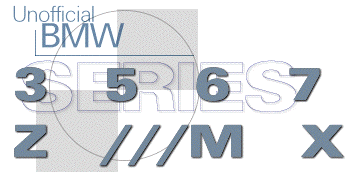|
Ron Stygar Carl Buckland Dale Beuning Forums Help
From digest.v7.n174 Tue Aug 26 20:03:44 1997 In Digest #159 Duane Collie writes:
>Now.....I'm sitting there looking at the rear springs with my H&Rs in hand. Well, I did provide this info way back in an earlier Digest, should have made the FAQ, but who knows? Anyways, changing your E36 M3 rear springs is easy once you know what to do. Whatever you do, DON"T REMOVE THE REAR AXLES like the factory manual says to do, it's just a way of squeezing a couple hundred more bucks out of a poor service customer. First, and most important, the rear emergency brake must be released to the off position when you are ready to remove the rear springs! If the e-brake is engaged (handle pulled up), the rear suspension binds up against the brakes and doesn't allow the control arms to drop far enough to remove the spring. Racers take note, the rear wheels will come up off the ground sooner when jacking the car up if the rear e-brake is on. Jack the rear of the car up enough to get the rear wheels off the ground 2 - 3 inches and put it on jackstands. Remove the rear wheels from the hubs. This may require putting on the e-brake temporarily to break loose the wheel studs if you didn't do it before you jacked the wheels up off the ground. If you put the e-brake on for this, be sure to release it once you have the wheels off! Place the jack under the center of the rear disc brake rotor and jack it up until it just touches the bottom of the disc. This is to support the suspension when you undo the lower shock mount bolt. It must touch the disc rotor itself, not the dustshield, otherwise you'll bend the dustshield! Remove the lower shock mount bolt (18mm I think). Once the lower shock bolt is removed, lower the jack. When you lower the jack the rear control arms should drop slightly. Repeat this procedure on the other side. Once you have completed removing the lower shock bolt from both sides, the rear suspension should should now be in the unsupported droop position. The stock springs will still be slightly tight in their perches. If you look at where the upper control arm meets the upper upright spindle mount you will notice that the outer half of the upper control arm is boxed in except at the outer end, where it is open. You must place a pry bar or small diameter pipe (the typical lowbuck floorjack lever handle works great here) into this opening to act as a lever arm and help push down on the upper control arm, lowering it enough to remove the springs. You may have to put your body weight into it, having an extra body to do it while you remove the spring would be the easiest way, but I've done it countless times by myself. You don't want to push down any more than is necessary to remove the spring. More is not better, unless you consider breaking something significant as better! The e-brake must be off or you'll never get enough suspension drop to remove the spring! Typically the rubber spring isolator pads pull out of the perch with the spring. This is the most difficult to do with stock springs, lowering springs are usually shorter and will slide in and out without having to torque the control arm down as much, depending on the particular spring. When you put the replacement spring in be sure to use the stock rubber spring isolator pads between the spring and the perch unless you don't mind your BMW creaking like an old trail wagon as it cruises down the road. BMW offers 3 different thickness top isolator pads for the E36 M3 rear springs. Most E36 M3's are delivered from the factory with the middle thickness, the other two are +/- 2.5mm (+\- 0.1") thicker than the middle one, so you can raise or lower the rear slightly per your needs, and there are possiblities if you have access to a set of corner scales (hint, hint Stock class racers). Because of the geometry between where the spring is located vs. where the wheel is located, the ride height change will actually be greater than the thickness of the isolator, so heads up! It's easiest to push the upper and lower rubber isolator pads onto the spring and install them all at one time. Once you have the springs located back in their perches you'll need to place the jack under the center of the rear disc rotor again (not the dustshield, dummy) and jack up the rear suspension until the lower rear shock bolt hole lines up between the lower shock eye and the threaded mounting hole on the upright. Screw in the shock bolt and torque to spec. Put the wheel on the hub, install the lugbolts and torque to spec. Repeat on the other side, jack up the rear, remove the jackstands, lower the rear to the ground, clean up your mess, and your ready to go for a ride. Believe me, I've done more difficult spring changing jobs, like the front struts. IMO, this isn't a difficult job. I've done it enough to be capable of swapping rear springs in 1/2 - 3/4 hour, but plan on 2 hours the first time through. |

